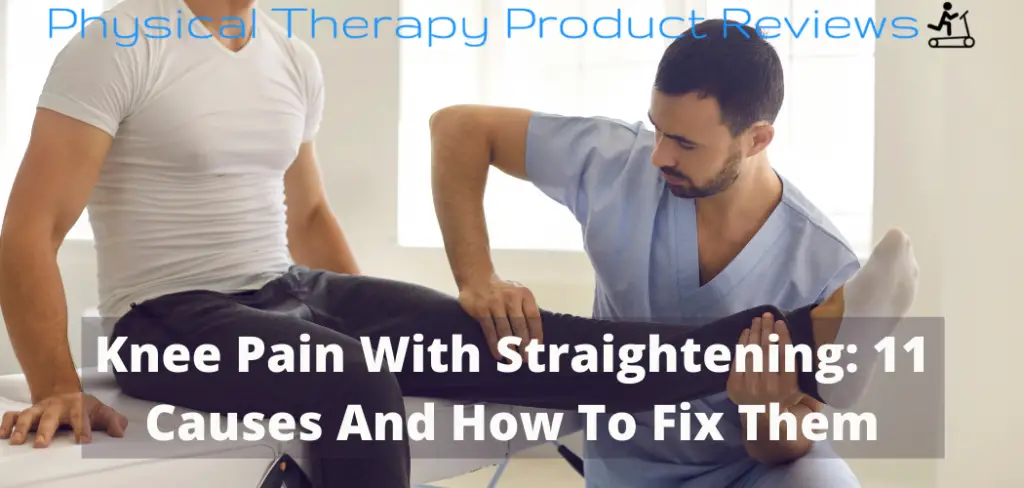Do you have pain when trying to straighten your knee? The cause of pain might not be what you think as there are many different reasons that you can have pain as you move into knee extension.
You might have pain when you are sitting with your knee bent and you feel a sharp pain as straighten it or possible when you’re walking and the knee starts to straighten out.
There are many reasons for pain with extension of the knee and it can be difficult to figure out which one is causing pain. We’ll go over the top causes, treatments, and other tips that will help speed up healing in this article.
11 Reason you can Have Pain with Knee Extension
We’ll review 11 causes of pain with straightening the knee. You can have more than one of the reasons at one time which can make it more challenging to diagnose. For all of the causes, we’ll review what they are and how we recommend improving your knee extension with that specific diagnosis.

Change of Swelling in the Knee
One of the most common causes of pain and stiffness with knee extension that we see is due to swelling after an acute injury.
The pain usually gets worse as you try and straighten your knee out, especially when there’s a lot of swelling in the joint. This can be very frustrating as the knee will feel full with more pressure.
It does not mean that you need surgery for this issue in most cases and most small injuries that cause swelling improve on their own in 6 weeks.
Related Topic: How to Decrease Swelling in the Knee
Meniscus Tear
Another common cause of pain with straightening the knee is a meniscus tear. There are two crescent-shaped discs called Menisci in between the Femur and Tibia (thigh bone and lower leg) on each leg.
When you move into extension, they act like shock absorbers that prevent your bones from grinding against one another. If you have a tear in one of these discs, it can be painful to straighten the knee. This is most noticeable when you are in weight-bearing such as with walking.
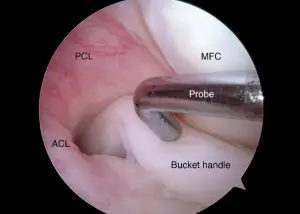
Many different types of meniscus tears can occur but the most problematic for straightening the knee is if you have a tear the flips up and impinges when you straighten. This can cause the knee lock and causes sharp pain.
Treatment for meniscus tears varies depending on the severity of the tear. In most cases, nonsurgical treatment is recommended and this might include ice/heat, physical therapy, and strengthening exercises. Surgery is only recommended if there is significant pain or catching with the knee.
Related Topic: Best exercises for meniscus tears
Knee Osteoarthritis
Pain from Osteoarthritis is common with knee extension. Osteoarthritis is the wear and tear of the joint over time. Once you have arthritis it can limit your ability to straighten and bend the knee.
The closer you get to full knee extension, the more joint compression there is inside the knee. You may also have pain when you try to bend the knee all the way too.
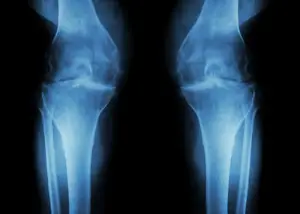
The pain may get worse as the day goes on but may feel better once the knee gets warmed up and moving. We do recommend using a compression sleeve brace for the early onset of arthritis to help with the pain.
Once the range of motion and pain become severe the best option at that point is a total knee replacement surgery.
Related Article: Can Patellofemoral Syndrome Cause Knee Arthritis
Chondromalacia
Chondromalacia is wear and tear underneath the kneecap that results in a loss of articular cartilage. There may be pain with knee extension as the kneecap moves up and down within the groove on the Femur and with activities such as stairs or squatting.
The pain of Chondromalacia is located around the knee cap but may not be localized to the same location each time you feel it. It’s generally described as an achiness and soreness around the knee cap but can also feel as if there is a grinding behind the knee cap.
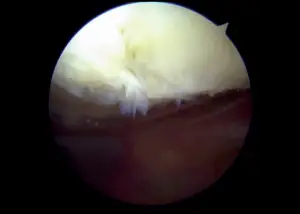
For Chondromalacia, we recommend two main avenues of treatment. The first is strengthening the muscles in the knee, especially the quadriceps muscles. This can be challenging to do without aggravating the knee.
The other option we recommend is wearing a knee brace that helps with patella stabilization until symptoms calm down. The knee brace will help reduce the pressure on the patella and help calm down some of the irritated nerves.
Related Article: How to Strengthen the Quad with Chondromalacia
Patella Bursitis
Bursitis is an inflammation of the bursa sacs in and around the knee. Many different pain patterns can occur with this problem including pain behind or under the kneecap but often the pain will get worse as you try to straighten your leg out. This can also be aggravated by kneeling on the knee or with forceful muscle use such as squats or lunges.
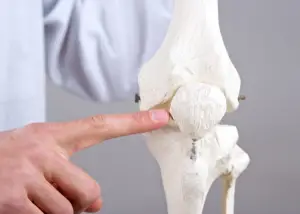
Swelling is typically localized on top of the knee cap or underneath it and usually doesn’t have to add too much swelling to the other areas of the knee.
Movement is one of the best ways to get rid of swelling in the Bursa. Walking, biking and general range of motion exercises help push fluid out of the leg and prevent further fluid accumulation.
Patellofemoral Pain Syndrome
Patellofemoral pain syndrome is pain over the front of the knee cap. It can be aggravated by activities such as stairs or squatting and usually produces pain that’s worse with activity, especially when going upstairs. It’s the result of too much force over a certain period of time on the patella.
The pain can present behind or on either side of the kneecap. This is an overuse injury that is most common in younger females but can affect people at any age.
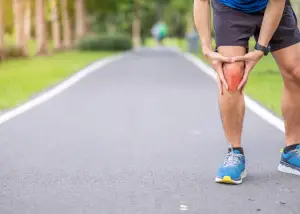
This is typically a result of a sudden increase in activity in someone that may not realize the lack of strength they have in the quad and hip muscles.
To treat this issue we recommend activity modifications along with hip and knee strengthening exercises.
Patellofemoral tracking issues typically take 6 weeks or longer to resolve with treatment. In addition to strengthening exercises, you can also try using foot orthotics that restrict motion in the leg and trial knee braces to help with patella forces.
Related Article: Best Knee Braces for Patella Tracking
Patella Tendonitis
Patella Tendonitis presents as pain at the Patellar Tendon where it attaches to the Tibia. It’s often aggravated by activities such as stairs, squatting, and jumping. It may feel like a sharp pain below your knee cap.
It can especially cause pain during knee extension when there is a resistive force or load on the leg causing more strain on the tendon.
Tendonitis is an overuse injury that usually occurs in people who are participating in full body weight activities such as running, jumping, or plyometrics.
Treatment of Patella Tendonitis includes activity modifications and progressive strengthening exercises to promote tendon remodeling. Be sure to avoid exercises that make the pain worse.
It is normal for pain with Patella Tendonitis to last up to six weeks or so before your body has time to repair itself.
Related Article: Best Knee Sleeve Brace
Hamstring and Calf Tightness
Tightness in the muscles on the back of your thigh and calf can lead to pain with straightening out your knee. This tightness can happen for many reasons including a protective reaction to a new injury and prolonged positioning of the knee in a bent position.
This is most common after surgery if you sleep with a pillow underneath the knee. The prolonged knee-bent positions from either sitting at a desk for too long or sleeping a pillow under the knee can make those muscles shorter. This can make it painful when you try to straighten the knee out.
To treat this, it’s important to maintain a good range of motion in the knee by doing gentle stretching exercises regularly.
Also, try not to sleep with a pillow underneath your knee after surgery or any new injuries.
Muscle Soreness
Muscle soreness can be a cause of pain with straightening the knee. This is especially common after participating in new or vigorous activities. When your muscles are worked harder than they’re used to it can cause delayed onset muscle soreness or what’s known as DOMS.
This delayed muscle soreness can be alarming to some people if you aren’t used to it and it can cause a moment of concern. However, it is completely normal and a good thing. It means that you are building the muscle back stronger!
This type of pain usually goes away within a few days as your body adapts to the new activity.
To get rid of the soreness you can try a few things to speed up recovery including foam rolling, light exercise, and using a therapeutic hot pack.
Related Topic: Best Foam Rolling to Reduce Knee Pain
Loose Body in the Knee Joint
Loose bodies in the knee joint can cause pain by straightening out your knee. This is often a pain that comes and goes and can be difficult to diagnose. The onset of pain may seem completely random.
A loose body is a fragment of bone or cartilage that has become dislodged from where it was originally located in the knee. It can move around freely causing pain and restriction of motion if it gets lodged in just the wrong spot.
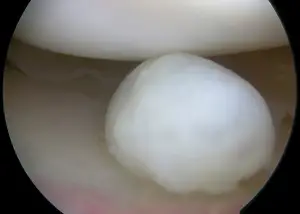
The cause of a loose body in the knee joint can be from many different things such as a previous injury, arthritis, or scar tissue from surgery.
Diagnosis can be difficult due to inconsistent symptoms and changing pain patterns. Loose bodies may show up on an x-ray or an MRI but they can be difficult to see if they are small in size.
Over time your body may be able to process the loose body but it may require surgery to go in and retrieve the foreign body.
Ligament Sprain or Tear
A ligament sprain or tear can also cause pain when trying to straighten the knee. This is often caused by a sudden twisting motion of the knee joint that’s common with cutting and changing directions. You’ll feel or hear a pop within the knee and feel as if the knee is unstable and may give out.
Ligaments are bands of tissue that connect one bone to another and they help stabilize the joint. When they are stretched too far or torn, it can cause pain when they are stretched to normal range of motion.
The body typically can heal on it’s own if it’s an LCL or an MCL tear but it can take nearly 12 weeks to recover. Physical therapy is recommended to work on a range of motion, strengthening, and getting back to normal activities.
If you suffer an ACL or a PCL injury, then these may require surgery to fix. These do require an MRI to correctly diagnose.
Related Topic: Best Knee Braces for LCL Tears
Conclusion
Knee pain with straightening the knee can be caused by many different things. If you are having pain, it’s important to get checked out by your doctor or physical therapist right away so they can diagnose what is causing your pain and help provide a treatment plan.
Other Great Physical Therapy Related Blog Posts
How to Stay Active After Cervical Fractures: Expert Tips and Advice
Dealing with Painful Stairs After Ankle Replacement Surgery
Walking After a Total Ankle Replacement: Tips for a Successful Recovery
Exercises While Non-Weight Bearing After Ankle Replacement: Elevation, AROM, Leg Raises, and More
Ankle Pain with Stairs: Causes and Home Treatment Options
5 Common Mistakes You’re Making After an Ankle Sprain
Disclaimer: The information provided in this post is for educational purposes only. This is not a substitute for a medical appointment. Please refer to your physician before starting any exercise program.
